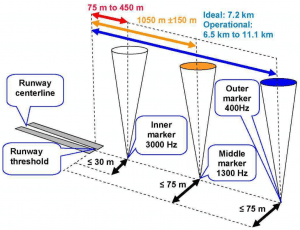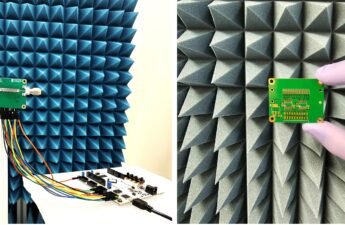Many airplanes can land with low visibility caused by fog. How is it possible? Enter the Instrument Landing System (ILS), meeting requests, it is this post’s subject.
When there is low visibility, the airplane is guided by radio waves to land in the right angle and be lined up with the runway. The components of Instrument Landing System are: localizer, glideslope and markers beacon.

Localizer
It is an array of antennas in the runway’s end, positioned horizontally. These are some localizer examples.


The antennas transmit two radio signals in frequencies 90 and 150 Hz, horizontally polarized. These signals are modulated to be transmitted in VHF with frequencies between 108 and 111.975 MHz. The localizer guides the aircraft to stay aligned with the runway’s center.

The airplane knows it is aligned when receives two signals of frequencies 90 and 150 Hz at the same time.
Glideslope
It is an array of antennas vertically positioned.

Sends two radio signals vertically polarized, in frequencies 90 and 150 Hz. Are modulated to transmit in UHF frequency between 329.30 and 335 MHz.

The glideslope guides the airplane to neither stays too high, neither too low. The right angle is when the aircraft receives both the 90 and 150 Hz signals. I already explained in the post about LCD, how light polarization works, since radio waves are electromagnetic waves like the light. Click here to read the post.
Markers beacon
Inform how close the airplane is from the runway. Usually, are 3 transmitters of 75 MHz with 2 W power. When the aircraft pass through a marker, it emits a sound inside the airplane cabin. Each marker transmit a sound in different frequency to aircraft.

Inside the airplane
The receivers to localizer and glideslope stay in the airplane’s nose and the marker beacon receiver stays below, close to the front wheel. This is the course and deviation indicator, serves to show the pilot if he is aligned with localizer and glideslope’s axes.

The pilot must keep the white lines in the dotted lines. In cabin, there are three lamps which indicate when the airplane passed through a marker beacon.
![]()
When the airplane passes through outer marker, the blue lamp blinks emitting a 400 Hz sound, passing through the middle, the orange blinks with a 1300 Hz sound and when passes through inner marker, the white blinks with a 3000 Hz sound. This video shows the Instrument Landing System in operation.



